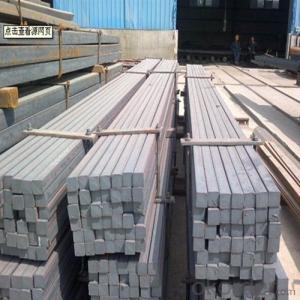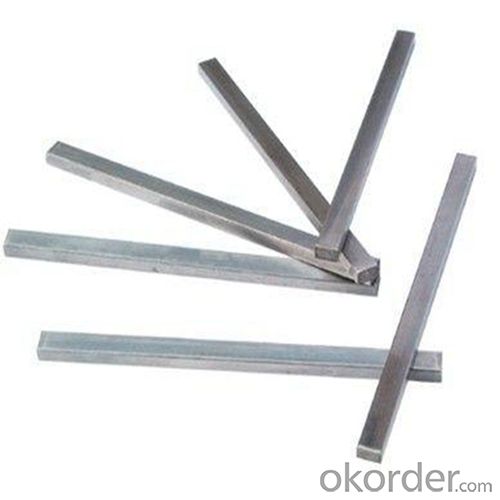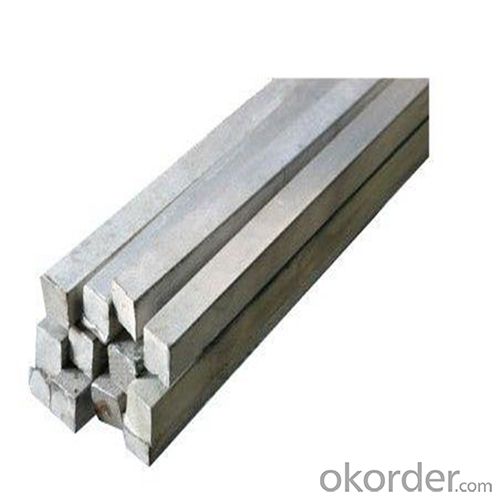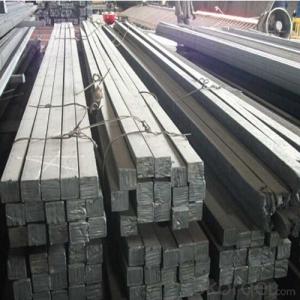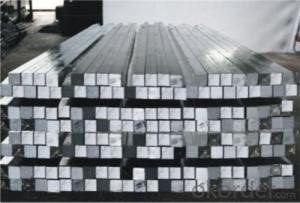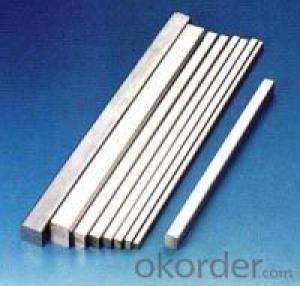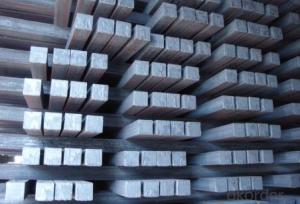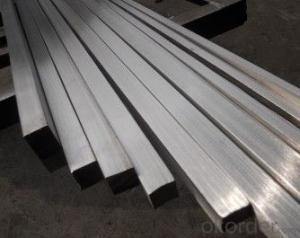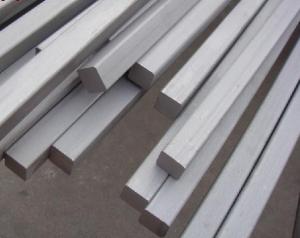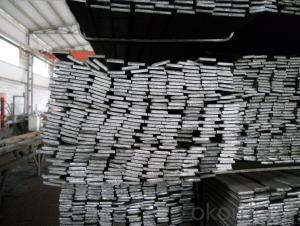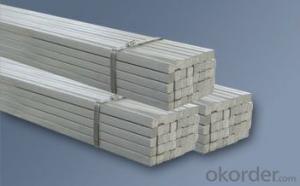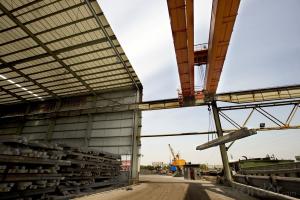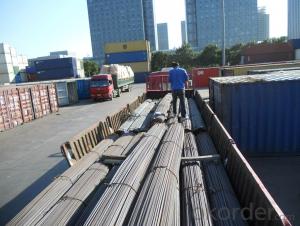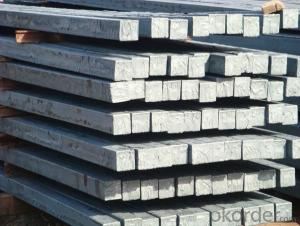Steel Long Product of Square Section Bar High Quality
- Loading Port:
- Tianjin
- Payment Terms:
- TT or LC
- Min Order Qty:
- 25 m.t.
- Supply Capability:
- 10000 m.t./month
OKorder Service Pledge
OKorder Financial Service
You Might Also Like
1. Structure of Steel Long Product of Square Section Bar Description:
Steel long product of square section bar is a bar with square shaped cross-section. It is special case of equal sides. Before steel products are sold on the market, the steel must first be processed into more functional pieces. Raw steel cannot be of use while in its pure form, thus it has to be cast into shape. The freshly made steel, steel long product of square section bar is still in the form of a metal bar or rectangle. Small sizes of steel long product of square section bar are used in ship building.
2. Main Features of Steel Long Product of Square Section Bar:
• Grade: Q235
• Type: Mild carbon steel
• A quadrilateral with four equal sides and four right angles.
• Vibration: The stiffness and mass are chosen to prevent unacceptable vibrations, particularly in settings sensitive to vibrations, such as offices and libraries.
• Local yield: Caused by concentrated loads, such as at the beam's point of support.
3. Steel Long Product of Square Section Bar Images:
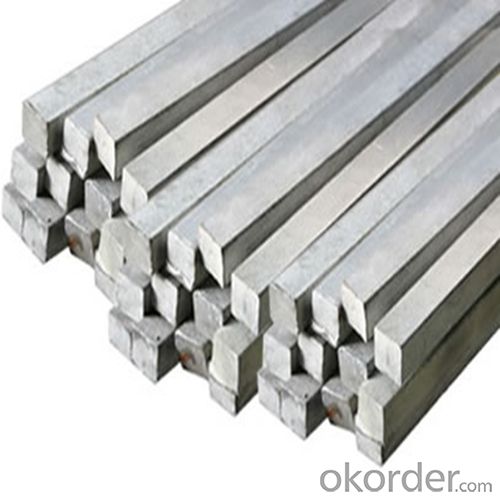
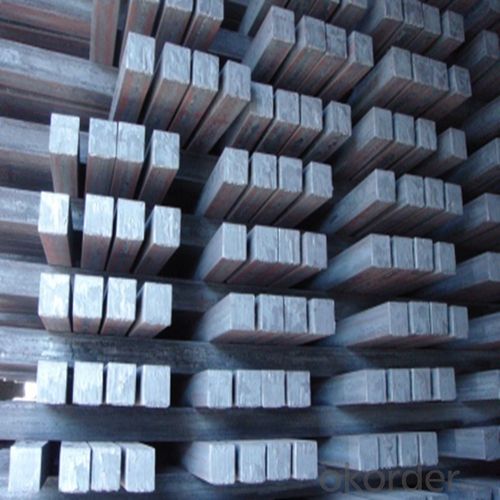
4. Steel Long Product of Square Section Bar Specification:
Mechanical Properties | Grade | Steel diameter(mm) | |||
≤16 | 16~40 | 40~60 | 60~100 | ||
Yield Point Δs/MPa | Q195 | ≥195 | ≥185 | - | - |
Q235 | 235 | 225 | 215 | 205 | |
Tensile Strength | Q195 | 315~390 | |||
Q235 | 375~500 | ||||
Elongation δ5% | Q195 | ≥33 | ≥32 | - | - |
Q235 | 26 | 25 | 24 | 23 | |
5. FAQ
We have organized several common questions for our clients,may help you sincerely:
①What is the main material?
There are two types of Square Bar, one is hot rolled square bar and other one is cold drawn square bar. Our principal products is hot rolled square bar. We dedicate to products with material Q195 and Q235. We offer products with high quality and low price.
②How to inspect the quality?
We have a professional inspection group which belongs to our company. We resolutely put an end to unqualified products flowing into the market. At the same time, we will provide necessary follow-up service assurance. How to guarantee the quality of the products?We have established the international advanced quality management system,every link from raw material to final product we have strict quality test;We resolutely put an end to unqualified products flowing into the market. At the same time, we will provide necessary follow-up service assurance.
③Is there any advantage about this kind of product?
Steel I beam bar IPE has a reduced capacity in the transverse direction, and is also inefficient in carrying torsion, for which hollow structural sections are often preferred.
- Q: Can a steel square be used for aligning fence posts?
- Indeed, aligning fence posts can be achieved through the utilization of a steel square. This highly versatile tool, known as a framing square, is capable of performing various carpentry tasks, one of which is aligning fence posts. Its design, resembling the shape of an "L," enables precise measurements and accurate right angle alignment, rendering it an ideal choice for guaranteeing correct positioning and uniform spacing of fence posts. By placing the steel square against each post and making adjustments until it attains perfect verticality, one can ensure that every post is properly aligned, thereby resulting in a fence that is both straight and sturdy. Moreover, a steel square can also be employed for assessing plumbness and squareness during the installation of cross braces or other fence components.
- Q: How do you use a steel square to lay out a right angle?
- To use a steel square to lay out a right angle, you will need to follow a few steps. First, place the square on a flat surface such as a workbench or table, ensuring that the long side of the square (also known as the blade) is aligned with the edge of the surface. Next, take a ruler or measuring tape and measure out the desired length for one side of the right angle. For example, if you want to create a right angle with sides measuring 6 inches, mark the 6-inch point on the surface using a pencil or marker. Once you have marked the desired length, slide the square along the surface until the blade aligns with the mark you made. The blade should be perpendicular to the edge of the surface, forming a 90-degree angle. To complete the layout of the right angle, use the blade of the square as a guide and draw a line along its edge. This line will be perpendicular to the edge of the surface, creating a right angle. Ensure that you hold the square firmly in place while drawing the line to maintain accuracy. Double-check the angle by using a protractor or another reliable method to confirm that it measures 90 degrees. By following these steps, you can effectively use a steel square to lay out a right angle with precision and accuracy.
- Q: How do you use a steel square to find angles for compound miter cuts?
- To use a steel square to find angles for compound miter cuts, you need to follow these steps: 1. Begin by understanding the concept of compound miter cuts. These cuts involve two angles: the bevel angle, which determines the tilt of the saw blade, and the miter angle, which determines the angle at which the material is cut horizontally. 2. Set the bevel angle on your saw to the desired tilt. This angle is usually indicated on the bevel scale of the saw or can be calculated using a protractor. 3. Take your steel square and position it against the fence of the saw, ensuring that the long edge of the square is parallel to the fence. 4. Place your workpiece against the square and align it with the edge of the square. Make sure the workpiece is flush against the fence. 5. Adjust the miter angle on your saw until the corner of the square is aligned with the desired angle for your cut. The corner of the square represents the intersection of the bevel and miter angles. 6. Once the miter angle is set, lock it in place on your saw. 7. Double-check your setup by making a test cut on a scrap piece of material. Measure the resulting angle using a protractor or a digital angle finder to ensure accuracy. Remember, compound miter cuts can be complex, so it's crucial to carefully understand the specific angles required for your project and adjust your saw accordingly. Additionally, always prioritize safety by wearing appropriate protective gear and using caution when operating power tools.
- Q: How do you use a steel square to mark out parallel lines on inclined surfaces?
- To use a steel square to mark out parallel lines on inclined surfaces, you first need to understand the concept of the steel square and its various components. A steel square consists of two arms – a longer one called the blade and a shorter one called the tongue. These arms meet at a right angle and have markings along their edges for measurements. To mark out parallel lines on inclined surfaces, follow these steps: 1. Begin by understanding the angle of inclination of the surface or slope you are working on. This is important to ensure accuracy in marking parallel lines. 2. Place the steel square on the inclined surface with the blade resting on the surface and the tongue aligned with the desired direction of the parallel lines. 3. With one hand, firmly hold the steel square in place to prevent any movement. 4. With the other hand, use a pencil or marker to mark along the edge of the tongue. This will create a straight line parallel to the inclined surface. 5. Repeat the process as needed, ensuring that the blade of the steel square remains in contact with the surface and the tongue remains aligned with the desired direction of the parallel lines. 6. If you need multiple parallel lines, you can use the markings on the blade to measure the desired spacing between the lines. Simply move the steel square along the surface while keeping the tongue aligned with the previous line and mark the new line accordingly. It is crucial to maintain a steady hand and proper alignment throughout the process to achieve accurate parallel lines. Additionally, ensure that the steel square is clean and free from any debris that may affect the markings.
- Q: Can a steel square be used for checking the alignment of a table router fence?
- Yes, a steel square can be used for checking the alignment of a table router fence. A steel square is a precise and reliable tool that can be used to check the perpendicularity of two surfaces. By placing the steel square against the fence and the table of the router, one can determine if the fence is perfectly perpendicular to the table or if it needs adjustment. This is important for ensuring accurate and consistent cuts when using a table router.
- Q: How do you use a steel square to lay out a diamond shape?
- To use a steel square to lay out a diamond shape, start by marking a reference line on the material using the long arm of the square. Then, align the short arm of the square with the reference line and mark a point to the left and right of the reference line to create the width of the diamond. Next, rotate the square 45 degrees and align the short arm with the left point previously marked. Mark a point above and below the reference line to determine the height of the diamond. Repeat this step for the right point. Finally, connect the points to form the diamond shape.
- Q: What are some common markings found on a steel square?
- Some common markings found on a steel square include inch and metric scales, degree measurements, and angles such as 45 and 90 degrees.
- Q: How do you use a steel square to determine the angle of a bevel cut?
- To use a steel square to determine the angle of a bevel cut, you can follow these steps: 1. Begin by placing the steel square on the edge of the material that you want to cut. Make sure that one arm of the square is aligned with the edge of the material, and the other arm is perpendicular to it. 2. Next, adjust the square so that the perpendicular arm is parallel to the surface you are working on. This will ensure accuracy in measuring the angle of the bevel cut. 3. Once the square is positioned correctly, take a protractor or a bevel gauge and place it against the angled edge of the square. Align the gauge with the perpendicular arm to measure the angle. 4. Read the measurement from the protractor or bevel gauge. This will give you the precise angle of the bevel cut. 5. Finally, transfer the measured angle to your saw or cutting tool by adjusting its bevel or miter gauge accordingly. This will ensure that your cut matches the desired angle. Using a steel square to determine the angle of a bevel cut is a simple and effective method, especially when precision is key. By following these steps, you can accurately measure and replicate the desired angle for your bevel cuts.
- Q: Can a steel square be used for measuring and marking compound bevel and miter cuts?
- Indeed, compound bevel and miter cuts can be measured and marked using a steel square. A steel square, also known as a framing square or carpenter's square, is a versatile tool commonly utilized in woodworking and construction. It possesses a 90-degree angle and a 45-degree angle, rendering it suitable for marking and measuring both bevel and miter cuts. To execute compound bevel cuts, which require the combination of two angles, a steel square can be employed to measure and mark the initial angle. By aligning the square's 45-degree angle with the desired bevel angle, one can utilize the square's edge to establish an accurate reference line for cutting. Similarly, for miter cuts, where two materials must be joined at an angle, a steel square can be employed to measure and mark the necessary angle. By aligning the square's 45-degree angle with the desired miter angle, precise markings for cutting can be created using the square's edge. Nevertheless, it is important to acknowledge that although a steel square can be used for measuring and marking compound bevel and miter cuts, it may not offer the same level of precision and accuracy as specialized tools like a bevel gauge or a miter saw. These specialized tools are explicitly designed for these types of cuts and provide enhanced precision and ease of use. Consequently, while a steel square can serve as a beneficial tool for basic measurements and markings, it is advisable to employ dedicated tools for more intricate compound bevel and miter cuts.
- Q: What are the different techniques for using a steel square in woodworking joinery?
- There are several techniques for using a steel square in woodworking joinery, each serving a specific purpose in achieving accurate and precise measurements and angles. Here are a few commonly used techniques: 1. Checking for squareness: One of the primary uses of a steel square is to ensure that the corners of a joint or workpiece are perfectly square. To do this, you can place the square against the edge of the workpiece and check if the adjoining edge is perpendicular to it. This technique is crucial for creating strong and stable joints. 2. Marking 90-degree angles: When you need to mark a 90-degree angle on a workpiece, a steel square comes in handy. Place the square against the edge of the workpiece and trace along the inside edge of the square with a pencil or marking knife. This technique ensures consistent and accurate marking for precise joinery. 3. Marking angles other than 90 degrees: Steel squares often come with additional markings that allow for the measurement and marking of angles other than 90 degrees. By aligning the desired angle measurement with the edge of the workpiece, you can accurately mark the angle needed for complex joinery. 4. Determining plumb and level: Steel squares can be used to check if a workpiece is plumb (vertical) or level (horizontal). By holding the square against the edge of the workpiece and using a spirit level or plumb bob, you can ensure that your project is properly aligned. 5. Transferring measurements: Steel squares can also be used to transfer measurements from one workpiece to another. By aligning the square against the edge of the first workpiece and marking the desired measurement, you can then transfer that measurement to the second workpiece using the square as a guide. 6. Creating mitered corners: When working with mitered corners, a steel square is essential for ensuring accurate angles. By placing the square against the workpiece and aligning it with the desired angle, you can mark and cut the joint precisely, resulting in clean and tight mitered corners. In summary, the steel square is a versatile and valuable tool for woodworking joinery. Whether you need to check for squareness, mark angles, determine plumb and level, transfer measurements, or create mitered corners, the steel square provides the precision and accuracy required for successful woodworking projects.
Send your message to us
Steel Long Product of Square Section Bar High Quality
- Loading Port:
- Tianjin
- Payment Terms:
- TT or LC
- Min Order Qty:
- 25 m.t.
- Supply Capability:
- 10000 m.t./month
OKorder Service Pledge
OKorder Financial Service
Similar products
Hot products
Hot Searches
Related keywords
